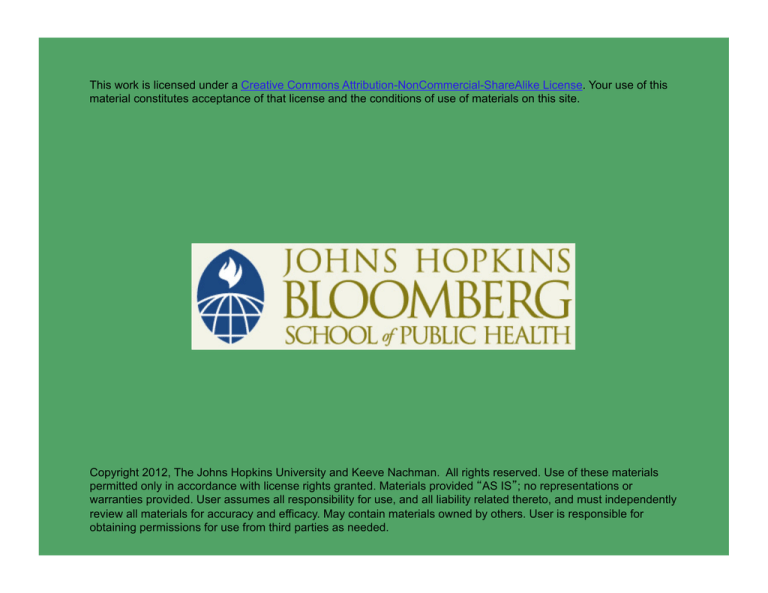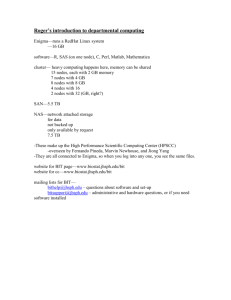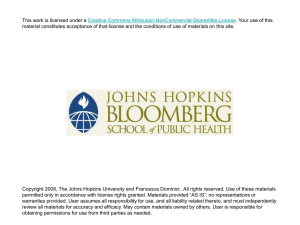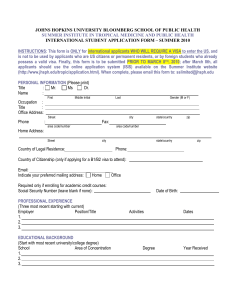
This work is licensed under a Creative Commons Attribution-NonCommercial-ShareAlike License. Your use of this
material constitutes acceptance of that license and the conditions of use of materials on this site.
Copyright 2012, The Johns Hopkins University and Keeve Nachman. All rights reserved. Use of these materials
permitted only in accordance with license rights granted. Materials provided “AS IS”; no representations or
warranties provided. User assumes all responsibility for use, and all liability related thereto, and must independently
review all materials for accuracy and efficacy. May contain materials owned by others. User is responsible for
obtaining permissions for use from third parties as needed.
Section B
What Are We Feeding Food Animals?
Copyright © 2012 Johns Hopkins University and Keeve Nachman. Creative Commons Attribution-NonCommercial-ShareAlike License 3.0.
What Are We Feeding Food Animals?
n
Antimicrobials/antibiotics and
synthetic hormones
n
By-products of slaughtered
animals and “rendered”
animals
n
Animal waste
n
Waste from industrial
processes
3
What Are We Feeding Food Animals?
n
Antimicrobials/antibiotics and synthetic hormones
n
By-products of slaughtered animals and “rendered” animals
n
Animal waste
n
Waste from industrial processes
4
What Are We Feeding Food Animals?
n
Antimicrobials/antibiotics and synthetic hormones
n
By-products of slaughtered animals and “rendered” animals
n
Animal waste
n
Waste from industrial processes
5
What Are We Feeding Food Animals?
n
Antimicrobials/antibiotics and synthetic hormones
n
By-products of slaughtered animals and “rendered” animals
n
Animal waste
n
Waste from industrial processes
6
What Are We Feeding Food Animals?
n
Antimicrobials/antibiotics and synthetic hormones
n
By-products of slaughtered animals and “rendered” animals
n
Animal waste
n
Waste from industrial processes
7
How Much Waste?
(Treated)
(Untreated)
Human waste
Animal waste
Generated per year
6.9 million dry tons
287 million dry tons
Applied to land per year
3.9 million dry tons
>270 million dry tons
Approximately one dry ton of animal waste generated for every US citizen
8
What’s in Animal Waste?
n
Bacteria
n
Protozoa
n
Viruses
n
Animal dander
n
Pharmaceuticals
Photo source: SRA Project.
n
Heavy metals
n
Hormones
n
Nutrients
9
What Happens to the Waste?
Image deleted because JHSPH OpenCourseWare could
not secure permission for its use.
10
From Waste to Water, Air, and Soil
n
Land application of waste
n
Failed storage systems
n
Waste incineration
n
Animal-house ventilation
n
Direct (illegal) releases into surface waters
Groundwater constitutes 40 percent of public water
supplies and 97 percent of rural water supplies
11
Other Transport Mechanisms
Image deleted because JHSPH OpenCourseWare could
not secure permission for its use.
12
Other Transport Mechanisms
Image deleted because JHSPH OpenCourseWare could
not secure permission for its use.
13
Other Transport Mechanisms
Image deleted because JHSPH OpenCourseWare could
not secure permission for its use.
14
Other Transport Mechanisms
Image deleted because JHSPH OpenCourseWare could
not secure permission for its use.
15
Other Transport Mechanisms
Image deleted because JHSPH OpenCourseWare could
not secure permission for its use.
16
Occupational Exposures
n
5,000,000 workers
n
No federal oversight
n
Personal protective equipment
n
Decontamination facilities
n
Workers and families
17
Air Quality Concerns
n
Releases of airborne contamination
from production sites
-
Gases
Ammonia, hydrogen
sulfide
Volatile organic
compounds
- Poultry houses—
mixture of about 60 unique VOCs (Traube, 2010)
- Swine production facilities—330 unique VOCs
(Schiffman, 2001)
-
-
-
-
Particulates
Microorganisms
Endotoxins
Animal dander
18
Air Quality Concerns
n
Health relevance of some is
established—less clear for others
n
Single pollutant exposure versus
mixtures
19
Community Exposures and Effects
n
Increased exposure to IFAP operation-borne contaminants
-
-
-
Asthma prevalence, hospitalizations
Allergy and eye, nose, and throat irritation
Mental health endpoints
n
Odors
- Compromised quality of life
n
Economic effects
- Direct property damage
- Housing values
20
Challenges in Characterizing PH Impact
n
Characterization of cumulative effects of stressors
-
n
Chemical, microbial, social, economic
Multiple, diverse exposed populations
-
-
Workers, fence line and surrounding communities, consumers
Relating adverse effects to exposures
21
Challenges in Characterizing PH Impact
n
Integrated nature of animal production
-
n
Gaps in current state of knowledge are extremely difficult to fill
No clear answers!
-
Though burden is borne by the public—externalities to
production process
-
Disproportionate burden on rural communities
22





